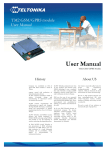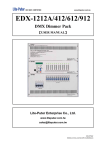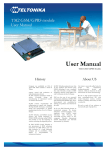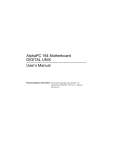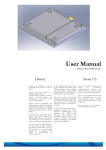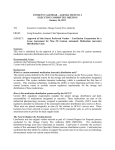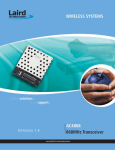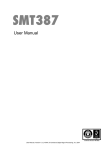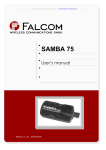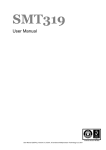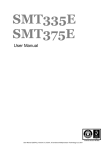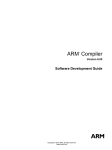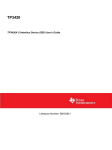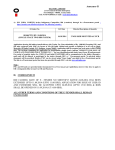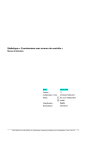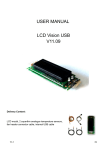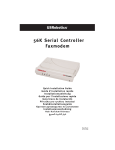Download User Manual
Transcript
3-2000733 GSM/GPRS Data Module User Manual Mipot S.p.A. 10/02/2006 Rev. 0 Pg. 1 HI-TECH COMPANY GSM/GPRS Data Module P.n.: 3-2000733 TABLE OF CONTENTS 1 Document Mission ................................................................................................................................................. 4 2 Glossary ................................................................................................................................................................. 4 3 Scope of Product ................................................................................................................................................... 7 4 Product environment.............................................................................................................................................. 7 5 4.1 Modem............................................................................................................................................................ 7 4.2 Memory........................................................................................................................................................... 7 4.3 Power Management........................................................................................................................................ 7 4.4 Interface.......................................................................................................................................................... 8 4.5 Miscellanous features ..................................................................................................................................... 8 Product functions ................................................................................................................................................. 10 5.1 System Features........................................................................................................................................... 10 5.2 Modem.......................................................................................................................................................... 13 5.3 RF High POWER .......................................................................................................................................... 15 5.4 Baseband...................................................................................................................................................... 16 5.5 Memory......................................................................................................................................................... 16 5.6 Clock ............................................................................................................................................................. 17 5.7 Voiceband..................................................................................................................................................... 18 5.7.1 Handset Mode ....................................................................................................................................... 18 5.7.2 Hands-Free............................................................................................................................................ 18 5.7.3 Ringer Mode .......................................................................................................................................... 18 5.8 Mechanical characteristics ........................................................................................................................... 19 5.9 Power supply ................................................................................................................................................ 20 5.9.1 Current consumptions ............................................................................................................................... 21 5.10 Power Saving ............................................................................................................................................ 24 5.10.1 E-POWERlite ............................................................................................................................................ 24 5.10.2 SMARTi..................................................................................................................................................... 25 5.10.3 Serial ports ................................................................................................................................................ 25 5.11 Security ..................................................................................................................................................... 25 5.12 GSM/GPRS modem functionalities........................................................................................................... 26 5.12.1 Supplementary services ........................................................................................................................ 26 5.12.2 Short Message Service ......................................................................................................................... 26 5.12.3 SIM Functionality ................................................................................................................................... 27 5.12.4 AT-command support............................................................................................................................ 27 5.12.5 Other basic features .............................................................................................................................. 27 5.13 Software tools ........................................................................................................................................... 27 5.13.1 SW development tools .......................................................................................................................... 27 5.13.2 Manufacturing tools ............................................................................................................................... 27 5.14 Page: 2/42 Lay-up and Shielding ................................................................................................................................ 28 Mipot reserves the right to change specifications without notice. Confidential HI-TECH COMPANY 6 GSM/GPRS Data Module P.n.: 3-2000733 User Interfaces..................................................................................................................................................... 29 6.1 PIN OUT description..................................................................................................................................... 29 6.2 SIM Interface ................................................................................................................................................ 31 6.3 Battery .......................................................................................................................................................... 32 6.4 Antenna interface.......................................................................................................................................... 32 6.5 Asynchronous Serial interface...................................................................................................................... 32 6.6 GPIO ............................................................................................................................................................. 33 6.7 Real Time Clock ........................................................................................................................................... 33 6.8 SW interfaces ............................................................................................................................................... 34 6.9 Audio interface.............................................................................................................................................. 40 6.9.1 Audio codecs ......................................................................................................................................... 40 6.9.2 Echo canceller/Noise Reduction ........................................................................................................... 40 6.9.3 DAI Mode............................................................................................................................................... 40 6.9.4 Audio devices ........................................................................................................................................ 40 6.9.5 Circuit Description ................................................................................................................................. 41 6.9.6 Polyphonic ringer................................................................................................................................... 41 6.10 ADC interface / Measurement interface.................................................................................................... 42 6.11 SPI............................................................................................................................................................. 42 6.12 I2C bus interface ....................................................................................................................................... 42 Page: 3/42 Mipot reserves the right to change specifications without notice. Confidential HI-TECH COMPANY GSM/GPRS Data Module P.n.: 3-2000733 1 Document Mission The User Manual provides all information necessary for a successful integration of 3-2000733 module into the application of the customer. Additionally, the User Manual contains all product functions for application. 2 Glossary Page: 4/42 Abbreviation / Term Explanation / Definition ADC Analog-to-Digital Converter ADN Abbreviated Dialling Numbers AFC Automatic Frequency Correction AND Abbreviated Dialing Number AMR Adaptive Multi Rate API Application Programming Interface ASC Asynchronous Serial Interface Controller BCCH Broadcast Control Channel BDN Barred Dialing Number CB Cell Broadcast CBCH Cell Broadcast Channel CCCH Common Control Channel CD Carrier Detect CGU Clock Generation Unit CLI Calling Line Identifcation CSD Circuit Switched Data DAI Digital Audio Interface DCE Data Communication Equipment DCS Digital Cellular System (1800 MHz) DCXO Digital Controlled Crystal Oscillator DL Reception DSP Digital Signal Processor DSR Data Set Ready DTE Data Terminal Equipment DTMF Dual Tone Multi Frequency DTR Data Transmit Receive EBU External Bus Interface Unit EFR Enhanced Full Rate EGSM Extended - Global System for Mobile Communication EMS Enhanced Messaging Service Mipot reserves the right to change specifications without notice. Confidential HI-TECH COMPANY GSM/GPRS Data Module Abbreviation / Term Explanation / Definition ESD Electro Static Discharge ETSI European Telecommunications Standards Institute FDN Fixed Dialing Number FFS Flash File System FR Full Rate GPIO Page: 5/42 P.n.: 3-2000733 General Purpose Input/Output rd GPP 3 Generation Partnership Project GPRS General Packet Radio System GSM Global System for Mobile Communication HR Half Rate HW Hardware IC Integrated Circuit I2C Inter-Integrated Circuit IIR Infinite Impulsive Response IMEI International Mobile Equipment Identity JTAG Joint Test Action Group LDN Last Dialing Number M2M Machine-to-Machine ME Mobile Equipment MIDI Musical Instrument Digital Interface MS Mobile Station MSC Multi-Slot Class N-AMR Narrow-AMR NOM Network Operating Mode NV Non Volatile PA Power Amplifier PC Personal Computer PBCCH Packet Broadcast Control Channel PCCCH Packet Common Control Channel PDP Packet Data Protocol PDU Protocol Data Unit PLMN Public Land Mobile Network PPS Protocol and Parameter Selection PST Protocol Stack Mipot reserves the right to change specifications without notice. Confidential HI-TECH COMPANY Page: 6/42 GSM/GPRS Data Module P.n.: Abbreviation / Term Explanation / Definition PWM Pulse Width Modulation RF Radio Frequency RTC Real Time Clock RX Receiver SAW Surface Acoustic(al) Wave SDN Service Dialing Number SIM Subscriber Identity Module SMA SubMiniature version A connector SMS Short Message Service SMS MO Short Message Service Mobile-Originated SMS MT Short Message Service Mobile-Terminated SPMidi Scalable Polyphony MIDI SPI Serial Peripheral Interface SSC Serial Synchronous Interface Controller STK SIM Toolkit SW Software TCH Traffic Channel TX Transmitter UART Universal Asynchronous Receiver-Transmitter UL Transmission Mipot reserves the right to change specifications without notice. 3-2000733 Confidential HI-TECH COMPANY GSM/GPRS Data Module P.n.: 3-2000733 3 Scope of Product 3-2000733 is a small, light weight and low power consumption module that enables digital communications services on GSM/GPRS networks for machine to machine or user to machine wireless applications. 3-2000733 modules are developed in compliance with internal and normative certification requirements. In particular, they are certified by CE approval report and Radio & Tele Terminal Equipment Directive (R&TTED) report. Requirements for lead-free components are imposed and satisfied. The product implements a dual-band MS able to operate in the frequency bands EGSM 900 MHz and DCS 1800 MHz; the dynamic behavior can be configured dynamically by disabling/enabling a specific band e.g. through AT commands. Eventually, the module can be configurated either dual-band or tri-band or quad-band. The supported power classes for both voice and data services will be: • • Class 4 (2W) for GSM band; Class 1 (1W) for DCS bands. The product implements a Class B Mobile Station, offering simultaneous access to GSM and GPRS services. Network operation modes I to III are supported, with user-definable preferred service between GSM and GPRS. The main buildings blocks of the module are E-GOLDlite (GSM/GPRS Baseband System, Infineon PMB7860) and E-POWERlite (Power Management, Infineon PMB6814). It’s possible connecting SIM card either with an on-board connector or with an external SIM connector. The core of the module is represented by the modem, constituted from E-GOLDlite, a power amplifier (TriQuint TQM7M4006), a transceiver (Infineon SMARTISD2 PMB6271) and a frontend (EPCOS DGM081M03). 4 Product environment 3-2000733 module is composed from the following blocks: • Modem; • Memory; • Power Management; • Interface; • Miscellanous features. 4.1 • • • • Modem Infineon E-GOLDlite PMB7860 GSM/GPRS Baseband System; Infineon SMARTISD2 PMB6271 V1.1 GSM 850/900/1800/1900 MHz Voice and Data Quad-Band/Multi-Slot Transceiver; TriQuint TQM7M4006 3V Quad-Band GSM850/900/DCS/PCS Power Amplifier Module with integrated power controller; Epcos DGM081M03 Quad Band Antenna Switch Module with integrated SAW filters for GSM850/900/1800/1900 Receiver. 4.2 • Memory Intel Multi-Chip Package 64Mbits 1.8V Flash and 16Mbits RAM RD38F2030W0YTQ0. 4.3 • • Power Management Infineon E-POWERlite PMB6814. All the modem power rails are supplied by E-POWERlite; Battery connector. Page: 7/42 Mipot reserves the right to change specifications without notice. Confidential HI-TECH COMPANY 4.4 • o o o o P.n.: 3-2000733 Interface SIM card holder supporting 1.8 V and 3 V card type via E-POWERlite (Suyin 254038MA006G505ZL); MMCX Interface connector for RF output (50 Ohm connector MMCX Edge Mount SMD J01341A0081 (Telegartner)); 60 pin board-to-board connector (MOLEX 54167-0608): Audio (2x analog, 1x digital), I2C bus, SPI bus, 2x ADC, 2x analog out (PWM), 10 GPIOs; 2 UART serial ports: one with HW handshake signals and the other one with SW flow control; Debug testpoints (JTAG) for C166 and for TEAKlite debug tools. 4.5 • GSM/GPRS Data Module Miscellanous features 40 tones polyphonic ring tones support. A block diagram and an overview of the module with the listed components are reported in the following pages. Image 1: 3-2000733 block diagram Page: 8/42 Mipot reserves the right to change specifications without notice. Confidential HI-TECH COMPANY GSM/GPRS Data Module Interface connector for RF output Telegartner J01341A0081 Triquint Power Amplifier 7M4006 Epcos Antenna Switch DGM081M03 P.n.: 3-2000733 Infineon Radio Transceiver SMARTi SD2 PMB6271 Infineon Micro Processor EGOLDlite PMB7860 Intel Memory 8 MB Flash 2 MB RAM RD38F2030W0YTQ0 Board-to-Board Connector Molex 54167-0608 Infineon Power Management EPOWERlite PMB6814 Image 2: 3-2000733 overview module Page: 9/42 Mipot reserves the right to change specifications without notice. Confidential HI-TECH COMPANY GSM/GPRS Data Module P.n.: 3-2000733 5 Product functions 5.1 System Features A comprehensive list of 3-2000733’s features is presented in the following table and further detailed in the following paragraphs. The features can be shared in the following sections: • Generic features; • GSM/GPRS modem functionalities; • Mechanical and Electronics features; • Software features; • Accessory support ; • Host SW tools. Set of features Type approval Environmental constraints Description CE approval report available Radio & Tele Terminal Equipment Directive (R&TTED) report available Requirements for lead-free components Platform security concept description available Security Secure IMEI management Secure flashing environment Secure memory area Software update Software update using system connector Module testing SW Service software API functionality Rewrite IMEI Manage SIM locks Backup and restore user data Defect logger to analyze memory trace Manufacturing requirements GSM standard compliancy Flashing throughput (for 8 Mbytes memory) : 400 kbps ETSI GSM Phase 2+ (R99) EGSM 900 MHz Frequency Bands DCS 1800 MHz Disable band/Manual band selection GPRS multi-slot class (MSC) 10 (4+1, 3+2) GPRS PBCCH/PCCCH support CBCH reception when on PBCCH supported GSM/GPRS Data Services GPRS Class B and CC Coding scheme CS-1, CS-2, CS-3, CS-4 Network operation mode I, II, III CSD up to 9.6kbps (V.32, V.110) FAX G3, Class 2.0 SMS Short message service Page: 10/42 Short Message Service Mobile-Terminated (SMS MT) Mipot reserves the right to change specifications without notice. Confidential HI-TECH COMPANY GSM/GPRS Data Module Set of features P.n.: 3-2000733 Description Short Message Service Mobile-Originated (SMS MO) SMS-CB Cell Broadcast (SMS CB) Concatenated SMS Via GSM or GPRS Text and PDU mode Abbreviated Dialling Numbers (ADN) Fixed Dialling Numbers (FDN) SIM Functionality Last Dialled Numbers (LDN) Service Dialling Numbers (SDN) SIM Lock protection SIM Toolkit Network Network subset SIM Locks Service provider Corporate Operator Display of Called Number Indication of Call Progress Signals Country/PLMN Indication Short Message Indication and Acknowledgement Basic Mobile Station features International Access Function Service Indicator Dual Tone Multi Frequency (DTMF) Subscription Identity Management On/Off Switch Service Provider Indication Call Hold (CH) Call Waiting (CW) Multi-Party (MTPY) Call Forwarding (CF) Explicit Call Transfer (ECT) GSM Supplementary services Call Barring (CB) Calling Line Identification Presentation (CLIP) Calling Line Identification Restriction (CLIR) Connected Line Identification Presentation (COLP) Connected Line Identification Restriction (COLR) Unstructured Supplementary Services Data (USSD) Audio Codecs Page: 11/42 Speech codecs FR (Full rate) / EFR (Enhanced Full Rate) / HR (Half Rate) Mipot reserves the right to change specifications without notice. Confidential HI-TECH COMPANY GSM/GPRS Data Module Set of features P.n.: 3-2000733 Description Speech codecs AMR (Adaptive Multi Rate) Encryption algorithms Mechanical features Encryption algorithms A5/1 Encryption algorithms A5/2 Number of RF shield required = 1 Number of PIN's used for SW flashing = 3 (RX/TX and Ground) RF connector Connector Board to board connector SIM holder RTC Real Time Clock (RTC) supported with alarm capabilities SIM connector on-board or external SIM voltage: 1.8 and 3 V SIM High-speed interface External SIM ESD protection required. External SIM connector support Flash Memory Largest capacity single memory chip 16MB Maximum FFS data write rate 20 Kbytes/s Largest capacity single memory chip 4 MB RAM Memory providers supported: Intel Page mode support Protection circuitry integrated on the platform Battery Charging of deeply discharged battery must be possible. Charging during phone call Maximum charging current of battery :1100 mA Audio features Audio filter types supported Handsfree and headset operation Echo canceller Noise reduction Number of GPIO-interfaces 6 Number of UART's 2 I/O Interfaces Number of free UART's for user : 1 One UART with complete 9-pin UART 1 Max speed UART (AT commands) 115.2 kbps One UART with RX/TX 1 Power on Call Handling Power on time (sec) 3 sec Redial missed and/or received calls (CLI) Abbreviated Dialling Full duplex Call phone Ringtones Polyphonic ringtones Page: 12/42 Mipot reserves the right to change specifications without notice. Confidential HI-TECH COMPANY GSM/GPRS Data Module Set of features P.n.: 3-2000733 Description HR, FR, EFR, AMR Audio formats integrated with the hardware MIDI 1.0 iMelody Number of simultaneous polyphonic tones (without extra HW) 40 Accessory support Audio headset Charger Tracing tools available SW development tools Audio tools available PC application development tools available Manufacturing tools 5.2 Flashing tools available RF tuning tools available Modem The modem part provides with minimal component’s list all functionality necessary for voice and data transmission over GSM and GPRS network. The modem is divided in two separated areas surrounded by traces on which metal boxes can be soldered. The first area encloses the RF High power components and the remaining passive components of the transceiver; the second area groups baseband processor, memory, crystals and power management unit. The modem is designed as a four-band transceiver, i.e. GSM850/900/1800/1900. The modem is composed from the following components: o Infineon E-GOLDlite PMB7860 GSM/GPRS Baseband System; o Infineon SMARTISD2 PMB6271 V1.1 GSM 850/900/1800/1900 MHz Voice and Data Quad-Band/Multi-Slot Transceiver; o Epcos DGM081M03 Quad Band Antenna Switch Module with integrated SAW filters for GSM850/900/1800/1900 MHz Receiver; o Infineon E-POWERlite PMB6814. All the modem power rails are supplied by E-POWERlite; o Intel Multi-Chip Package 64Mbits 1.8V Wireless Flash and 16Mbits RAM RD38F2030W0YTQ0. Page: 13/42 Mipot reserves the right to change specifications without notice. Confidential HI-TECH COMPANY GSM/GPRS Data Module RF High Power P.n.: 3-2000733 Baseband Memory Power Management RF Transceiver Image 3: Overview of main parts of 3-2000733 module Page: 14/42 Mipot reserves the right to change specifications without notice. Confidential HI-TECH COMPANY 5.3 GSM/GPRS Data Module P.n.: 3-2000733 RF High POWER Core of RF part is the SMARTiSD2 transceiver which performs modulation and up-conversion of I/Q signal as well as down-conversion and demodulation of the RF received signals. The interface between E-GOLDlite and SMARTiSD2 is balanced I/Q analog signal, time shared by transmitter and receiver. Programming of SMARTiSD2 transceiver is done through dedicated 3-wires interface of E-GOLDlite. Timing are provided by the built-in GSM Timer Unit of E-GOLDlite; the antenna switch and PA are commanded via trigger signal TOUT0, TOUT[2..3]. SMARTiSD2 provides two different RF TX outputs respectively for 850/900 and 1800/1900 bands. TriQuint TQM7M4006 PA amplifies these signals maintaining two separate paths. The PA is directly connected to the VBAT supply. The power ramp control is provided by E-GOLDlite to the PA module, which has a built-in power controller. Quad Band Epcos antenna switch integrates SAW filters and matching for all the RX paths. It is directly connected to the RX inputs of SMARTiSD2. The RF I/O signal is by default provided to 50ohm SMA connector. Printed antenna is selectable as RF I/O interface by soldering some matching components. Image 4: 3-2000733 RF High Power block diagram Page: 15/42 Mipot reserves the right to change specifications without notice. Confidential HI-TECH COMPANY 5.4 GSM/GPRS Data Module P.n.: 3-2000733 Baseband 3-2000733 baseband system provides all necessary interfaces for design a realistic phone and additional interface for hardware/software designing and debugging. Phone design includes the following interfaces: • SIM card holder supporting 1.8 and 3V card type. • System connector on phone with serial data I/O with handshake signals. Outside phone design there are the following interfaces: • 2 UART: ASC0 with hardware handshake signals and ASC1 without flow control. Both of them are accessible on Molex board-to-board connector and supports high speed dataflow. • Debug connectors (JTAG) for C166 and for TEAKlite debug tools. Image 5: 3-2000733 Baseband block diagram 5.5 Memory GSM modem is equipped with Intel RD38F2030W0YTQ0 Multi-Chip–Memory combo: • 64 Mbits 1.8V Flash; • 16 Mbits RAM; • ROM footprint amount to ca 4MB; • A max of 2MB is provided to a file system service of customizable size; Page: 16/42 Mipot reserves the right to change specifications without notice. Confidential HI-TECH COMPANY GSM/GPRS Data Module P.n.: 3-2000733 • The maximum storable file size is 1 MB. • The maximum FFS data write rate is 20 Kbytes/s. Page mode is supported for enhanced system performance. 5.6 Clock The 26MHz master clock is generated by SMARTiSD2 with a fully integrate digital controlled crystal oscillator (DCXO), whose signal is used as a reference frequency for the radio synthesizer and also provided to the baseband IC, after a buffer amplifier. The only external component needed for oscillator is a quartz crystal. The oscillator and buffer are supplied by VRF2: powering it up activates the 26MHz clock. The baseband provide Automatic Frequency Correction (AFC) to SMARTiSD2 with control words sent on the 3wires interface to guarantee the GSM frequency stability requirements. E-GOLDlite has built-in Clock Generation Unit (CGU) that generates and distributes the suitable clock signals to all the baseband sections. The Real Time Clock (RTC) is implemented with a 32 KHz quartz crystal for E-GOLDlite internal oscillator. Image 6: Block diagram of 3-2000733 clock system Page: 17/42 Mipot reserves the right to change specifications without notice. Confidential HI-TECH COMPANY 5.7 5.7.1 GSM/GPRS Data Module P.n.: 3-2000733 Voiceband Handset Mode The normal voiceband functional mode of the phone is completely handled by E-GOLDlite: - Microphone bias current is provided by internal regulator VMIC; - Microphone signal is directly connected to input MICP1/MICN1; - Earpiece is directly driven by EPPAx outputs and it’s connected by pass-through wires on the top of the display module; - Additional HandSet Plug is located outside phone design. 5.7.2 Hands-Free In hands-free mode several hardware connections allow multiple mode of operation. In standard mode, the microphone signal comes from the external stereo head-set device and is connected to MICP2/MICN2 inputs of E-GOLDlite. Voice output from E-GOLDlite EPP1 is connected to the Stereo Audio Amplifier (in mono), and then to the external audio device. In viva voice mode of operation, the output signal of EPP1/EPN1 is amplified by the built-in Audio amplifier of EPOWERlite, and then applied to the Loudspeaker output. Loudspeaker (mechanical assembled with earpiece) is connected by pass-through wires on the top of the display module. 5.7.3 Ringer Mode The ringer tones are generated by E-GOLDlite built-in generator and then they are amplified by E-POWERlite amplifier before being applied to loudspeaker. Otherwise, the generated ringer signal might be applied to the Stereo audio amplifier that serves the head-set external device. Image 7: 3-2000733 audio interface block diagram Page: 18/42 Mipot reserves the right to change specifications without notice. Confidential HI-TECH COMPANY 5.8 GSM/GPRS Data Module P.n.: 3-2000733 Mechanical characteristics The Number of RF shield required is 1. For mechanical characteristics of GSM/GPRS module refer to the following images: Image 8: 3-2000733 3D representation Page: 19/42 Mechanical and environment Value Size Weight Operating temperature range 33 x 38 x 5.6 mm < 10 g From -20°C to +55°C Mipot reserves the right to change specifications without notice. Confidential HI-TECH COMPANY 5.9 GSM/GPRS Data Module P.n.: 3-2000733 Power supply The on board power supply is derived by Molex connector that provides a voltage value VBAT on pins 1, 3, 5, 7. The range of VBAT is between 3.3 V and 4.3 V, while typically its value is 3.8 V. Description Min Typ Max Supply voltage 3.5 V 3.8 V 4.2 V The modem starting from this VBAT voltage derives all the needed voltage levels to supply the different circuit parts by the power management IC Infineon E-POWERlite PMB6814. Image 9: Power supply block diagram Page: 20/42 Mipot reserves the right to change specifications without notice. Confidential HI-TECH COMPANY GSM/GPRS Data Module P.n.: 3-2000733 The supply domain might have different setting and they are programmed via a dedicated EP_I2C bus (implemented with SW driver) by E-GOLDlite at startup. All the other programming of the E-POWERlite are performed in the same way. Please refer to the Infineon datasheets for detailed specifications. E-POWERlite should be pin-to-pin compatible with S/M-POWER PMB6811. Supply name Supply domain Voltage level SDBB V_SD LBB1 VBB1 LBB2 VBB2 LANA LINT LSIM1 VANA VINT VSIM LSIM2 LRTC 2V85 VRTC 1.92 V 1.86 V 1.80 V 1.50 V 1.50 V 1.65 V 1.50 V 1.65 V 2.65 V 2.72 V 2.85 V 1.8 V 2.85 V 2.11 V LRFC VRF0 1.5 V LRF1 LRF2 LMMC VRF1 VRF2 VMMC 2.5 V 2.5 V 2.85 V Supply device remarks Step-Down converter: E-GOLDlite core (Input for LBB1 and LBB2 baseband supply) + External Bus Unit of E-GOLDlite + Memories E-GOLDlite DSP (TEAKlite) supply (supplied by SDBB) E-GOLDlite core supply including C166 (supplied by SDBB), Main, PLL power supply Analog Supply of E-GOLDlite DIGA, DIGB and external SIM holder External and internal SIM interface N. A. Ultra-low zero-load current for Real Time Clock supply SMARTi-SD2 Core (supplied by SDBB via VDDC input) SMARTi-SD2 main supply SMARTi-SD2 Antenna switch The voltage levels written in bold are the output voltage values after start-up. The PA is directly supply by VBAT. Two hot spots can be considered: the PA, and the E-POWERlite. The heat dissipation is based on the thermal resistance reduction around these two components by using a large number of vias in those regions. 5.9.1 Current consumptions Current consumptions of the module are reported in the following pages. All measurements have been performed at the following conditions: Power OFF current: < 30 µA. BAND: GSM900 TEST SETTINGS: DRX: 5 BA LIST arfcn: 1 9 17 26 34 42 50 58 67 75 83 91 99 108 116 124 PCL: 5 Page: 21/42 Mipot reserves the right to change specifications without notice. Confidential HI-TECH COMPANY GSM/GPRS Data Module P.n.: 3-2000733 GSM900 Idle mode Average current: 1.16 mA GSM900 Allocated mode Average current: 144.92 mA Image 10: Current consumption at 900 MHz Page: 22/42 Mipot reserves the right to change specifications without notice. Confidential HI-TECH COMPANY GSM/GPRS Data Module P.n.: 3-2000733 BAND: GSM1800 TEST SETTINGS: DRX: 5 BA LIST arfcn: 512 530 560 580 610 640 670 700 720 740 760 790 810 840 860 PCL: 0 GSM1800 Idle mode Average current: 1.13 mA GSM1800 Allocated mode Average current: 105.63 mA Image 11: Current Consumptions at 1800 MHz Page: 23/42 Mipot reserves the right to change specifications without notice. Confidential HI-TECH COMPANY GSM/GPRS Data Module P.n.: 3-2000733 5.10 Power Saving Power saving is a special function that allows the reducing of power consumption during the idle time. If the clock increases, required power increases too. Therefore a solution for minimizing the power is the reducing of the master clock frequency when there aren’t activities. In this period the system doesn’t work with a clock of 26 MHz (“fast clock”) but with a clock of 32 KHz (RTC clock or “slow clock”). This switching between 26 MHz and 32 KHz clock is performed by SCCU (Standby Clock Control Unit). Main priorities of power saving are the following: 1. Reduce base (min) current consumption; 2. Minimize full-speed running periods, minimize power saving on/off switching; 3. Reduce max current consumption. These points are reported in the following figure: Image 12: Power saving priorities 5.10.1 E-POWERlite If the voltage decreases, the power decreases too. VCXO_en control voltage is applied to E-POWERlite to selectively shutdown supply voltage lines LRF0, LRF1 and LRF2 for radio frequency part. VCXO_en control voltage is used in PWM Ù PFM StepDown converter, since PFM mode requires less switching (less power) than PWM on light loads. Page: 24/42 Mipot reserves the right to change specifications without notice. Confidential HI-TECH COMPANY GSM/GPRS Data Module T T P.n.: T 3-2000733 T PWM mode - heavy load PWM mode – light load PFM mode - light load t t t Image 13: E-POWERlite comportament during Power Saving E-POWERlite built-in audio amplifier shall also shut down when unused via proper I2C messages. 5.10.2 SMARTi SMARTi and BaseBand are linked via a 3-wire bus (Clock, Data, and Enable). Since Enable is active low (and inactive high), it is forced low before enter power saving, else SMARTi will be pseudo supplied via Enable input junctions. This may be very harmful for relevant BaseBand output port HW and consumes power. Enable is restored high when power saving exits. Moreover SMARTi has also to be reinitialized, just like the first power up (stealth telegrams). Image 14: SMARTi comportament during Power Saving 5.10.3 Serial ports It is impossible to receive and send on Asynchronous Serial Communication (ASC) ports at standard speeds in power saving. DCE serial port relies on hardware flow control logic. DTE shall cache serial data flow if it senses CTS inactive (high logic). CTS is set inactive while power saving and set active while running at full speed and ready to receive. Since power saving exits at least every 2 seconds, DTE shall be capable to cache up to 2 seconds of information flow (host polling mode). System waits on a software timer for 5000 frames (23.077 sec) after the last valid character received, allowing immediate response, before re-enter power saving. Hardware flow control is currently supported only on ASC0, not on ASC1. 5.11 Security 3-2000733 supports a security module that prevents uncontrolled installation/updates of software on delivered products. The IMEI (International Mobile Equipment Identity) cannot not be changed after the ME’s final production process: the protection of the IMEI shall resist tampering, i.e. manipulation and change by any means (e.g. physical, electrical and software). The security module provides the required measures to fulfill these IMEI protection requirements. For protection against flash tampering, the system uses a unique Chip Identification Number for encryption and authentication of valid flash memory images. Page: 25/42 Mipot reserves the right to change specifications without notice. Confidential HI-TECH COMPANY GSM/GPRS Data Module P.n.: 3-2000733 A secure flashing environment is provided: in order to restrict communication with the ME only to authorized PC tools (e.g. production test equipment), the security module implements an authentication handshake with the PC tools that are provided with a suitable HW dongle. 5.12 GSM/GPRS modem functionalities 3-2000733 GSM/GPRS module integrates a full-featured R99 GSM-GPRS Protocol Stack, whose main characteristics are listed in the following. Refer to the PICS/PIXIT documentation for a detailed description of the Stack features. The module can be configurated either dual-band or tri-band or quad-band. The product implements a dual-band MS able to operate in the frequency bands EGSM 900 MHz and DCS 1800 MHz; the dynamic behavior can be configured dynamically by disabling/enabling a specific band e.g. through AT commands. The supported power classes for both voice and data services will be: • Class 4 for GSM band; • Class 1 for DCS bands. The product implements a Class B Mobile Station, offering simultaneous access to GSM and GPRS services. Network operation modes I to III are supported, with user-definable preferred service between GSM and GPRS. Optionally paging messages for GSM calls can be monitored during GPRS data transfer in not-coordinating network operation mode NOM II-III. PBCCH/PCCCH logical channels are supported, as well as CBCH reception. GPRS multislot 10 is implemented, implying a maximum of 4 slots in DL (reception) and 2 slots in UL (transmission) and 5 slots on the whole. Finally the GSM/GPRS module supported: • All coding schemes from CS1 to CS4; • As for the circuit switched services, speech channel modes HR and FR version 1, 2 and 3 (FR, HR, EFR, N-AMR) are supported; • Encryption algorithms A5/1 and A5/2 for GSM for GPRS are supported; • CS Data calls are supported in transparent/non transparent mode up to 9.6 kbps; • Bearer service fax Group 3 Class 2.0 is supported. Among access interfaces to DTE, both V.32 and V.110 are provided. 5.12.1 Supplementary services The following supplementary services are provided: • Call Hold (CH); • Call Waiting (CW); • Multi-Party (MTPY); • Call Forwarding (CF); • Explicit Call Transfer (ECT); • Call Barring (CB); • Calling Line Identification Presentation (CLIP); • Calling Line Identification Restriction (CLIR); • Connected Line Identification Presentation (COLP); • Connected Line Identification Restriction (COLR); • Unstructured Supplementary Services Data (USSD). 5.12.2 Short Message Service Mobile-originated as well as mobile-terminated SMS are supported. Text and PDU mode are supported. Reception of SMS during circuit-switched calls is supported. Reception of SMS via GPRS is also supported. SMS SIM storage is provided. Page: 26/42 Mipot reserves the right to change specifications without notice. Confidential HI-TECH COMPANY GSM/GPRS Data Module P.n.: 3-2000733 5.12.3 SIM Functionality Among SIM functionalities, the following services of the SIM are supported: • Abbreviated Dialing Numbers (ADN); • Fixed Dialing Numbers (FDN); • Last Dialed Numbers (LDN); • Service Dialing Numbers (SDN); • ME Personalization (SIM Lock). ME Personalization handling is a mechanism to tie the ME operation to one specific SIM card or to a limited range of SIM cards from a given Network Operator or Service Provider. The ME will only accept the SIM if there is a positive match between the personalization code group(s) stored in the ME and the code group(s) belonging to the inserted SIM. The SIM Lock feature supported by the GSM/GPRS module enables ME personalization through the following personalization categories: • Network lock; • Network subset lock; • Service provider lock; • Corporate lock; • Operator lock. SIM Toolkit R 99 is supported. For a detailed description of the STK features, refer to the PICS/Pixit documentation. 5.12.4 AT-command support The modem functionalities and services are provided through a rich serial AT-command interface. All supported standard as well as proprietary AT commands are detailed in the table of SW interface. 5.12.5 Other basic features Within the scope of the M2M or user interface, the following indications and functionalities are supported: • Display of Called Number; • Indication of Call Progress Signals; • Country/PLMN Indication; • Short Message Indication and Acknowledgement; • International Access Function; • Service Indicator; • Dual Tone Multi Frequency (DTMF); • Subscription Identity Management; • Service Provider Indication; • Abbreviated Dialing; • Power on (external input). 5.13 Software tools The GSM/GPRS module supports a development tool suite that caters for trace, programming target flash, calibration and production testing. 5.13.1 SW development tools A trace tool is supported to debug the software behavior through serial communication port 2 (UART1). Almost all supported AT commands can be entered on the trace port itself for sake of usability. 5.13.2 Manufacturing tools Manufacturing/llaboratory tools comprise: • Flashtool, a multithreaded application to handle the download of software to target (up to 8 target concurrently), conceived to be used in manufacturing sites and hardware key protected; Page: 27/42 Mipot reserves the right to change specifications without notice. Confidential HI-TECH COMPANY GSM/GPRS Data Module P.n.: 3-2000733 • Phonetool, an application to handle the target software’s functionalities, giving access to several driver functionalities such RF, Audio, FFS, EEPROM, power management, etc. In particular, Phonetool provides support for: • the generation of EEPROM maps used to access the target EEPROM from host; • the generation of EEPROM structures defaults; • the FFS formatting of the file system binary image file; • RF calibration; • Audio filters measurements and tuning. 5.14 Lay-up and Shielding 3-2000733 GSM/GPRS modem is placed and routed on a single face of 6 layers build up printed circuit board. Electronics parts are placed on both sides. The RF connections traces dimensions are calculated to achieve the wanted characteristic impedance and are placed on Layer4. Layer 3 is full ground. Layer5 is also mostly RF ground under sensible RF parts, with suitable clearance over components pads. The VBATT track is routed on Layer2 and Layer5. Quad band printed antenna elements are on Layer6 and Layer1. The following picture shows the lay-up main dimensions. Image 15: Lay-up main dimensions (Surface Finishing: Chemical Gold Plate Ni 5 uM / Au 0.1 uM) Page: 28/42 Mipot reserves the right to change specifications without notice. Confidential HI-TECH COMPANY GSM/GPRS Data Module P.n.: 3-2000733 6 User Interfaces 6.1 PIN OUT description A 60-pin connector is provided to interface of 3-2000733 module for the power supply, SIM interface, audio interface (2 x analog, 1x digital), I2C bus, SPI bus, 2 x analog in (ADC), 2 x analog out (PWM), 2 UART serial ports, and 10 GPIOs. PIN # Name I/O Function I/O type Description 1 VBAT PWR GSM Power Supply From 3.3 to 4.3 V (Typ: 3.8 V) 2 GND PWR GSM Power Supply Ground 3 VBAT PWR GSM Power Supply From 3.3 to 4.3 V (Typ: 3.8 V) 4 GND PWR GSM Power Supply Ground 5 VBAT PWR GSM Power Supply From 3.3 to 4.3 V (Typ: 3.8 V) 6 GND PWR GSM Power Supply Ground 7 VBAT PWR GSM Power Supply From 3.3 to 4.3 V (Typ: 3.8 V) 8 GND PWR GSM Power Supply Ground Should be connected with pins 3, 5, 7 Should be connected with pins 4, 6, 8 Should be connected with pins 1, 5, 7 Should be connected with pins 2, 6, 8 Should be connected with pins 1, 3, 7 Should be connected with pins 2, 4, 8 Should be connected with pins 1, 3, 5 Should be connected with pins 2, 4, 6 9 VCHARGE PWR GSM Power Supply 10 DCD O Asynchronous Serial Interface 0 11 VCHARGE PWR GSM Power Supply 12 DTR I Asynchronous Serial Interface 0 13 SIM_VCC I/O SIM interface 14 CTS_0 I Asynchronous Serial Interface 0 15 SIM_IO I/O SIM interface 16 RTS_0 O Asynchronous Serial Interface 0 17 SIM_CLK O SIM interface 18 RXD_0 I Asynchronous Serial Interface 0 19 SIM_RST O SIM interface 20 TXD_0 O 21 MRST0/GPIO I/O 22 RI O Page: 29/42 Asynchronous Serial Interface 0 Synchronous Serial Interface (SPI compatible) Asynchronous Serial Interface 0 0 - 12V (Typ: 6V) Current limited to 600 mA CMOS 3.3V compatible 0 - 12V (Typ: 6V) Current limited to 600 mA CMOS 3.3V compatible Supply 1.8V-3.3V CMOS 3.3V compatible CMOS 3.3V compatible CMOS 3.3V compatible CMOS 3.3V compatible CMOS 3.3V compatible CMOS 3.3V compatible CMOS 3.3V compatible CMOS 3.3V compatible CMOS 3.3V compatible Mipot reserves the right to change specifications without notice. Should be connected with pin 11 Data Carrier Detect Should be connected with pin 9 Data Terminal Ready SIM power supply Clear To Send SIM I/O serial data Request to Send SIM clock signal Receive Serial Data SIM reset signal Transmit Serial Data Master Receive Slave Transmit Ring Indicator Confidential HI-TECH COMPANY GSM/GPRS Data Module PIN # Name I/O 23 MTSR0/GPIO I/O 24 DSR O 25 SCLK0/GPIO I/O 26 RXD_1 I 27 SCL/GPIO O I2C bus interface 28 TXD_1 O Asynchronous Serial Interface 1 29 SDA/GPIO I/O I2C bus interface 30 KEYOUT0/GPIO I/O Keypad interface / GPIO 31 CLK0_DAI/GPIO I/O Digital Audio Interface 32 KEYOUT1/GPIO I/O Keypad interface / GPIO 33 RXD_DAI/GPIO I Digital Audio Interface 34 KEYOUT2/GPIO I/O Keypad interface / GPIO 35 TXD_DAI/GPIO O Digital Audio Interface 36 KEYOUT3/GPIO I/O Keypad interface / GPIO 37 WA0_DAI/GPIO I/O Digital Audio Interface 38 KEYOUT4/GPIO I/O Keypad interface / GPIO 39 EXTRSTn I External reset 40 KEYOUT5/GPIO I/O 41 MICP1 42 P.n.: 3-2000733 Function I/O type Description Synchronous Serial Interface (SPI compatible) Asynchronous Serial Interface 0 Synchronous Serial Interface (SPI compatible) Asynchronous Serial Interface 1 Master Transmit Slave Receive Keypad interface / GPIO CMOS 3.3V compatible CMOS 3.3V compatible CMOS 3.3V compatible CMOS 3.3V compatible CMOS 3.3V compatible CMOS 3.3V compatible CMOS 3.3V compatible CMOS 3.3V compatible CMOS 3.3V compatible CMOS 3.3V compatible CMOS 3.3V compatible CMOS 3.3V compatible CMOS 3.3V compatible CMOS 3.3V compatible CMOS 3.3V compatible CMOS 3.3V compatible CMOS 3.3V compatible CMOS 3.3V compatible I Audio Interface Analog KEYIN0/GPIO I/O Keypad interface / GPIO CMOS 3.3V compatible 43 MICN1 I Audio Interface Analog 44 KEYIN1/GPIO I/O Keypad interface / GPIO CMOS 3.3V compatible 45 EPPA1B O Audio Interface Analog 46 KEYIN2/ON I/O Keypad interface / Power on CMOS 3.3V compatible 47 EPPA2A O Audio Interface Analog 48 KEYIN3/GPIO I/O 49 MICP2 I Keypad interface / GPIO Audio Interface CMOS 3.3V compatible Analog Page: 30/42 Mipot reserves the right to change specifications without notice. Data Set Ready Shift Clock Receive Serial Data Serial Clock Line Transmit Serial Data Serial Data Line Keypad output pin 0 / GPIO 00 DAI Clock Keypad output pin 1 / GPIO 50 DAI Receive Keypad output pin 2 / GPIO 01 DAI Transmit Keypad output pin 3 / GPIO 02 DAI Reset Keypad output pin 4 / GPIO 03 External HW reset Keypad output pin 5 / GPIO 04 Handset microphone reference Keypad input pin 0 / GPIO 05 Handset microphone bias Keypad input pin 1 / GPIO 06 Balanced audio out Keypad input pin 2 / Power on button /GPIO 07 Balanced audio out Keypad input pin 3 / GPIO 08 Handset microphone Confidential HI-TECH COMPANY PIN # GSM/GPRS Data Module Name I/O Function P.n.: I/O type 50 CAP19/GPIO I/O Capture Compare / GPIO CMOS 3.3V compatible 51 MICN2 I Audio Interface Analog 52 CAP02/GPIO I/O Capture Compare / GPIO CMOS 3.3V compatible 53 AUOP O Audio Interface Analog 54 CAP05/GPIO I/O Capture Compare / GPIO CMOS 3.3V compatible 55 AUON O Audio Interface Analog 56 CAP06/GPIO I/O Capture Compare / GPIO 57 ADC1 I Measurement interface 58 CAP00_EX5IN/GPIO I/O Capture Compare / GPIO / External Interrupt 59 ADC2 I Measurement interface 60 CAP22_EX3IN/GPIO I/O Capture Compare / GPIO / External Interrupt CMOS 3.3V compatible ADC 12bits 0-2.5V CMOS 3.3V compatible ADC 12bits 0-2.5V CMOS 3.3V compatible 3-2000733 Description reference Capture Compare 19 / GPIO 47 Handset microphone bias Capture Compare 02 / GPIO 57 Balanced power audio out Capture Compare 05 / GPIO 28 Balanced power audio out Capture Compare 06 / GPIO 30 Analog to Digital Converter Capture Compare 00 / GPIO 30 / Ext Int 5B Analog to Digital Converter Capture Compare 22 / GPIO 55 / Ext Int 3 Image 16: Board-to-Board connector overwiew 6.2 SIM Interface 3-2000733 module can be equipped with an on-board SIM connector or an external SIM connector. High-speed SIM/ME interface is implemented. Both 1.8V and 3V SIM type will be supported (1.8/3V ME); activation and deactivation with automatic voltage switch from 1.8V to 3V are implemented, according to ISO-IEC 78-16-e Specifications. The SIM driver supports the PPS (Protocol and Parameter Selection) procedure for baud-rate selection, according to the values proposed by the SIM Card. Clock stop is supported at both high and low level. Finally, external SIM ESD protection is required. Page: 31/42 Name PIN # I/O I/O type Description SIM_VCC SIM_IO 13 15 I/O I/O Supply 1.8V 3.3V CMOS 3.3V compatible SIM Power Supply SIM I/O Serial Data Mipot reserves the right to change specifications without notice. Confidential HI-TECH COMPANY 6.3 GSM/GPRS Data Module Name PIN # I/O SIM_CLK SIM_RST 17 19 O O I/O type CMOS 3.3V compatible CMOS 3.3V compatible P.n.: 3-2000733 Description SIM Clock Signal SIM Reset Signal Battery The supported type for the battery shall be Li-Ion rechargeable only; default system will support 650mAh nominal. Protection circuitry is integrated on the module. The Battery/Charger functionality provides: • battery charging control, i.e. constant voltage charging and trickling of charging in order to maintain the full capacity of the battery; • pulse charge mode, to improve capacity estimation accuracy; • capacity estimation during charging, no charging, ongoing calls, etc., constantly considering the different load parameters of the phone; • Measurements of battery voltage, RF and battery temperature, equipment status, etc. Charging of deeply discharged battery as well as charging during phone call is possible. The module has a current consumption lower than 3mA during idle mode reception, lower than 300 mA in connected mode on GSM band and lower than 180mA in connected mode on DCS band (measurements are performed following the GSM Association Battery Life Measurement Technique Document). The charging battery range goes from 400 to 1100 mA with a step of 100 mA. Name PIN # I/O I/O type Description VBAT GND VBAT GND VBAT GND VBAT GND 1 2 3 4 5 6 7 8 PWR PWR PWR PWR PWR PWR PWR PWR From 3.3 to 4.3 V (Typ: 3.8 V) Ground From 3.3 to 4.3 V (Typ: 3.8 V) Ground From 3.3 to 4.3 V (Typ: 3.8 V) Ground From 3.3 to 4.3 V (Typ: 3.8 V) Ground Should be connected with pins 3, 5, 7 Should be connected with pins 4, 6, 8 Should be connected with pins 1, 5, 7 Should be connected with pins 2, 6, 8 Should be connected with pins 1, 5, 7 Should be connected with pins 2, 4, 8 Should be connected with pins 1, 5, 7 Should be connected with pins 2, 4, 6 VCHARGE 9 PWR From 0 to 12 V (Typ: 6V) Current limited to 600 mA Should be connected with pin 11 VCHARGE 11 PWR From 0 to 12 V (Typ: 6V) Current limited to 600 mA Should be connected with pin 9 6.4 Antenna interface A 50 Ohm SMA connector is provided as antenna connector for GSM functionality. 6.5 Asynchronous Serial interface Two serial ports (ASC0 UART and ASC1 UART) are supported working at the selected baud rate (default 115.2 kbps): on ASC0 complete 9 pin serial port is supported and power saving wakeup is available. This interface is fully RS232 9-pin logical compliant and support full HW flow control. Default UART configuration implies ASC0 devoted to AT interface, ASC1 available for debug/tracing (only RX/TX lines). Page: 32/42 Mipot reserves the right to change specifications without notice. Confidential HI-TECH COMPANY GSM/GPRS Data Module P.n.: 3-2000733 These serial interfaces are available complying with V.24 protocol and the signals are: • TX Data (TXD_0); • RX Data (RXD_0); • Request to Send (RTS_0); • Clear to Send (CTS_0); • Data Terminal Ready (DTR); • Data Set Ready (DSR). To avoid floating if output pins are high-impedance, use pull-up resistors tied to GSM_VDD or pull-down resistors tied to GND. The first 6 pin reported in the table refer at the first serial interface, while the last two refer at the second serial interface. 6.6 Name PIN # I/O I/O type Description DCD DTR CTS_0 RTS_0 RXD_0 TXD_0 RI DSR RXD_1 TXD_1 10 12 14 16 18 20 22 24 26 28 O I I O I O O O I O CMOS 3.3V compatible CMOS 3.3V compatible CMOS 3.3V compatible CMOS 3.3V compatible CMOS 3.3V compatible CMOS 3.3V compatible CMOS 3.3V compatible CMOS 3.3V compatible CMOS 3.3V compatible CMOS 3.3V compatible Data Carrier Detect Data Terminal Ready Clear To Send Request to Send Receive Serial Data Transmit Serial Data Ring Indicator Data Set Ready Receive Serial Data Transmit Serial Data Serial interface # Asynchronous Serial Interface 0 Asynchronous Serial Interface 1 GPIO All General Purpose I/O (GPIOs) shall be initialized to proper direction / output logic level as soon as possible. If supply is removed from external device, relevant GPIOs should be placed at low logic level, or decoupled. 6.7 Name PIN # I/O I/O type Description GPIO 0 GPIO 1 GPIO 2 GPIO 3 GPIO 4 GPIO 5 GPIO 6 GPIO 7 30 32 34 36 38 40 42 44 I/O I/O I/O I/O I/O I/O I/O I/O CMOS 3.3V compatible CMOS 3.3V compatible CMOS 3.3V compatible CMOS 3.3V compatible CMOS 3.3V compatible CMOS 3.3V compatible CMOS 3.3V compatible CMOS 3.3V compatible KEYIN2/ON 46 I/O CMOS 3.3V compatible GPIO 8 48 I/O CMOS 3.3V compatible GPIO 00 GPIO 50 GPIO 01 GPIO 02 GPIO 03 GPIO 04 GPIO 05 GPIO 06 Power on button/GPIO 07 GPIO 08 Real Time Clock Real Time Clock (RTC) is integrated within the module and is implemented with a quartz crystal of 32 KHz and an E-GOLDlite internal oscillator. Page: 33/42 Mipot reserves the right to change specifications without notice. Confidential HI-TECH COMPANY GSM/GPRS Data Module P.n.: 3-2000733 The RTC time and alarm settings are retained also with battery removed; the system uses a capacitor based system with a backup time of 20 sec. 6.8 SW interfaces The AT-command interface provides the service and the functionalities of GSM/GPRS modem. It is possible observe the AT commands of 3-2000733 module in the following table. Name Command description General Commands +CGMI +CGMM +CGMR +CGSN +CSCS +CIMI +CCID +GCAP A/ Manufacturer identification Request model identification Request revision identification Request product serial number identification Set TE character set Request international mobile subscriber identification Card identification Request complete capability list Repeat last command Mobile equipment control and status commands +CPAS +CPWROFF +CFUN +CBC +CIND +CMER +CCLK +CALA +CRSM +CALM +CRSL +CLVL +CMUT +CCWE +CSGT +CALD +CTZU +CTZR +CLAC +CMEE Phone activity status Switch off the MS Set phone functionality Battery charge Indicator control Mobile termination event reporting Clock Alarm Restricted SIM access Alert sound mode Ringer sound level Loudspeaker volume level Mute control Call meter maximum event Set greeting text Delete alarm Automatic Time Zone Update Time Zone Reporting List all available AT commands Report mobile termination error Call control commands +CSTA D T P Page: 34/42 Select type of address Dial command (full support of modifiers: ;,>,I,G) Select tone dialing Select pulse dialing Mipot reserves the right to change specifications without notice. Confidential HI-TECH COMPANY GSM/GPRS Data Module Name A H M L +CMOD +CHUP +CEER +VTD +VTS DL S0 P.n.: 3-2000733 Command description Call answer Hook control Monitor speaker mode Monitor speaker loudness Call mode Hang up call Extended error report Tone duration DTMF and tone generation Redial last telephone number Automatic answer Network service commands +CNUM +CSQ +COPS +CREG +CPOL +COPN Subscriber number Signal quality Operator selection Network registration Preferred operator list Read operator names Security commands +CPIN +CLCK +CPWD Enter PIN Facility lock Change password Phonebook commands +CPBS +CPBR +CPBF +CPBW Select phonebook memory storage Read phonebook entries Find phonebook entries Write phonebook entry Short message commands +CSMS +CPMS +CMGF +CSAS +CRES +CSDH +CNMI +CMGR +CNMA +CMGL +CMGS +CMGW +CMSS +CSMP +CMGD Page: 35/42 Select message service Preferred message storage Preferred message format Save settings Restore settings Show text mode parameters New message indication Read message New message acknowledgement to ME/TA List message Send message Write message to memory Send message from storage Set text mode parameters Delete SMS Mipot reserves the right to change specifications without notice. Confidential HI-TECH COMPANY GSM/GPRS Data Module Name +CSCA +CSCB P.n.: 3-2000733 Command description Service center address Select cell broadcast message types Supplementary services commands +CCFC +CCWA +CLIR +CLIP +COLP +COLR +CAOC +CACM +CAMM +CPUC +CHLD +CTFR +CLCC +CSSN +CUSD +CCUG +CNAP Call forwarding Call waiting Calling line identification restriction Calling line identification presentation Connected line identification presentation Connected line identification restriction Advise of charge Accumulated call meter Accumulated call meter maximum Price per unit and currency table Call related supplementary services Call deflection List current list calls Supplementary service notifications Unstructured supplementary service data Closed user group Calling name presentation Data commands +CBST +FCLASS +CR +CRC +CRLP Select bearer service type Service class selection and identification Service reporting control Cellular result codes Radio link protocol FAX class 2.0 commands +FDT +FDR +FIP +FKS +FK +FAA +FAP +FBS +FBO +FBU +FCC +FCQ +FCR +FCS +FCT +FEA Page: 36/42 Transmit data Receive data Initialize facsimile parameters Session termination Session termination Adaptive answer Address & polling capabilities Buffer size Data bit order HDLC frame reporting DS capabilities parameters Copy quality checking Capability to receive data Current session results DTE phase C response timeout Phase C received EOL alignment Mipot reserves the right to change specifications without notice. Confidential HI-TECH COMPANY GSM/GPRS Data Module Name Command description +FFC +FHS +FIE +FIS +FIT +FLI +FLO +FLP +FMI +FMM +FMR +FMS +FNR +FNS +FND +FPA +FPI +FPP +FPS +FPW +FRQ +FRY +FSA +FSP Format conversion Call termination status Procedure interrupt enable Current session parameters Inactivity timeout Local ID string Set flow control Indicate document to poll Request manufacturer identification Request model identification Request revision identification Minimum phase C speed Negotiation reporting Non-standard frame FIF octet string NSF message data indication Selective polling address Local polling ID string Packet protocol control Page status Password parameter Receive quality thresholds Error correction mode retry count Sub Address parameter Request to poll P.n.: 3-2000733 V.24 control and V.25ter commands Z &F &C &D &S &K &W &V &Y I +GMI +GMM +GSN +GMR +ICF +IFC \Q +IPR O Page: 37/42 Reset to default configuration Set to factory defined configuration Circuit 109 (CD) behavior Circuit 108/2 (DTR) behavior DSR override Flow control Store current configuration Display current configuration Designate a default reset profile Request identification information Request manufacturer identification Request model identification Request product serial number identification Request revision identification DTE-DCE character framing DTE-DCE local flow control Set flow control Fixed DTE rate Return to on-line data state Mipot reserves the right to change specifications without notice. Confidential HI-TECH COMPANY GSM/GPRS Data Module Name S2 S3 S4 S5 S6 S7 S8 S10 S12 E Q V X P.n.: 3-2000733 Command description Escape character Command line termination character Response formatting character Command line editing character Pause before blind dialing Connection completion timeout Command dial modifier time Automatic disconnect delay Escape prompt delay (EPD) Command echo Result code suppression DCE response format Result code selection and call progress monitoring control Specific AT commands # +CGED +TRACE +XBANDSEL +XCALLSTAT +XGENDATA +XGCNTRD +XGCNTSET +XHANDSFREE +XL1SET +XSIO Production test command GPRS cell environment description Switch on/off trace Select band Set reporting call status Display generation and SW version Read counters of sent or received GPRS data Set/reset counter of sent or received GPRS data Set hands free mode Call the L1-specific function Configuration trace and modem (AT) interfaces SIM toolkit +STKPRO +STKTR +STKENV +STKPROF +STKCC +STKCNF SIM-APPL-TK proactive commands SIM-APPL-TK terminal response SIM-APPL-TK envelope SIM-APPL-TK terminal profile SIM-APPL-TK call control commands SIM-APPL-TK proactive session status GPRS AT commands +CGDCONT +CGEREP +CGQREQ +CGQMIN +CGATT +CGACT +CGDATA +CGAUTO +CGPADDR +CGCLASS Page: 38/42 Define PDP context GPRS event reporting Quality of service profile (requested) Quality of service profile (minimum acceptable) GPRS attach or detach PDP context activate or deactivate Enter data state Automatic response to a network request for PDP context activation Show PDP address GPRS mobile station class Mipot reserves the right to change specifications without notice. Confidential HI-TECH COMPANY GSM/GPRS Data Module Name +CGREG +CGSMS Page: 39/42 P.n.: 3-2000733 Command description GPRS network registration status Select service for MO SMS messages Mipot reserves the right to change specifications without notice. Confidential HI-TECH COMPANY 6.9 6.9.1 GSM/GPRS Data Module P.n.: 3-2000733 Audio interface Audio codecs The following speech codecs are supported in firmware on the DSP: • GSM Half Rate (TCH/HS); • GSM Full Rate (TCH/FS); • GSM Enhanced Full Rate (TCH/EFR); • 3GPP Adaptive Multi Rate (AMR) (TCH/AFS+TCH/AHS). 6.9.2 Echo canceller/Noise Reduction For better handling of speech calls and audio functionalities, the product supports algorithms for echo cancellation, noise suppression and automatic gain control. 6.9.3 DAI Mode For certification testing of audio and vocoder functions the mobile phone has to be connected to the system simulator. The Digital Audio Interface between the system simulator and the MS is supported as described in GSM 04.14 specifications. Supported modalities are: • Normal mode; • Vocoder test; • Acoustic test; • Voiceband test. The table below shows the PIN number related to the DAI signals. 6.9.4 Name PIN # I/O Type Description CLK0_DAI RXD_DAI TXD_DAI WA0_DAI 31 33 35 37 I/O I O I/O CMOS 3.3V compatible CMOS 3.3V compatible CMOS 3.3V compatible CMOS 3.3V compatible DAI clock DAI receive DAI Transmit DAI Reset Audio devices Handset A standard handset is supported for normal handset operation on the default audio path. Headset Two earpiece headsets are supported and may be used for voice during calls. The audio path switching from handset to headset and back is automatic when the headset jack is inserted or removed. In headset mode uplink audio path is switched to the headset microphone and headset button works for call accept/release. Microphone The uplink path can be switched between the handset and the headset microphone. The path switching is driven automatically by the headset jack. The uplink path can be muted. Hands-free A true hands-free functionality is implemented using high power loudspeaker, MS microphone and appropriate DSP algorithms for voice band handling (Echo canceller and Automatic Gain control). The product is equipped with a power audio amplifier that can drive an external 8 ohm speaker with 400mW peak. Page: 40/42 Mipot reserves the right to change specifications without notice. Confidential HI-TECH COMPANY GSM/GPRS Data Module P.n.: 3-2000733 The audio power amplifier can be used as a voice amplifier for the handsfree functionality and as a melody player amplifier for ringer functionality. The melody player could be the Midi synthesizer or the tone generator. In order to minimize the clipping of the audio signal, the polarization voltage can be adapted to the voltage supply (battery voltage). The audio signal on the loudspeaker is a mono signal. 6.9.5 Circuit Description The output signal of EPP1/EPN1 is amplified by the built-in Audio amplifier of E-POWERlite, and then applied to the Molex Connector: Image 17: Linking between E-GOLDlite and connector for audio interface The table below shows the PIN number related to the analog audio signals. 6.9.6 Name PIN # I/O I/O type Description MICP1 MICN1 EPPA1B EPPA2A MICP2 MICN2 AUOP AUON 41 43 45 47 49 51 53 55 I I O O I I O O Analog Analog Analog Analog Analog Analog Analog Analog Handset microphone reference Handset microphone bias Balanced audio out Balanced audio out Handset microphone reference Handset microphone bias Balanced power audio out Balanced power audio out Polyphonic ringer Polyphonic ring-tones can be generated by an internal MIDI synthesizer, which runs at 16 or 32 KHz sample frequency and can sum up to 40 voices at 16 kHz sampling rate. Page: 41/42 Mipot reserves the right to change specifications without notice. Confidential HI-TECH COMPANY GSM/GPRS Data Module P.n.: 3-2000733 The synthesizer output is only mono and cannot be mixed with TCH voice path (the two are mutually exclusive). To perform in-band alerting during TCH with voice path open, only Tone Generator can be used. The output samples of the synthesizer are post processed by two modules: • High Frequency Shelving Filter: This module is implemented as a first order IIR Filter, which is mainly used for high frequency boost in audio signals. Its transfer function can be controlled by 4 filter coefficients. • Audio Compressor: The audio compressor is a device for manipulating the dynamic range of mono or stereo audio signals. The audio compressor can be controlled by 14 configuration parameters. Polyphonic standard format supported. The MIDI driver can play: • MIDI files conforming to: o General Midi Level 1.0 with file-format 0 and 1; o General Midi Lite 1.0. • SPMidi (Scalable Polyphony MIDI) files conforming to: o SPMidi 1.0. • iMelody files conforming to: o iMelody v.1.2 specifications. 6.10 ADC interface / Measurement interface 2 inputs for Analog-to-Digital Converter are supported. The resolution of these converters is of 12-bit with a range of 0-2.5 Volt. Name PIN # I/O I/O type Description ADC1 ADC2 57 59 I I ADC 12bits 0-2.5V ADC 12bits 0-2.5V Analog to Digital Converter Analog to Digital Converter 6.11 SPI The SPI bus includes a clock signal, and two signals for the transmissions of the master and the slave. Name PIN # I/O I/O type Description MRST0/GPIO MTSR0/GPIO SCLK0/GPIO 21 23 25 I/O I/O I/O CMOS 3.3V compatible CMOS 3.3V compatible CMOS 3.3V compatible Master Receive Slave Transmit Master Transmit Slave Receive Shift Clock 6.12 I2C bus interface The I2C bus interface includes a serial clock and a serial data line. Page: 42/42 Name PIN # I/O I/O type Description SCL/GPIO SDA/GPIO 27 29 O I/O CMOS 3.3V compatible CMOS 3.3V compatible Serial Clock Line Serial Data Line Mipot reserves the right to change specifications without notice. Confidential










































